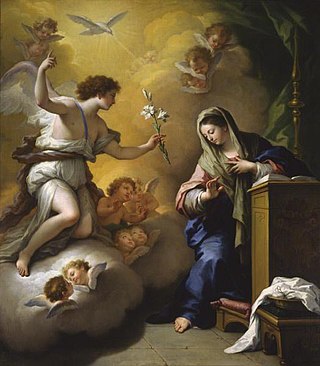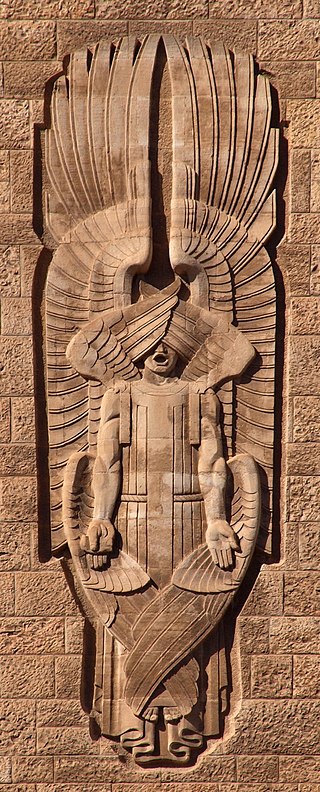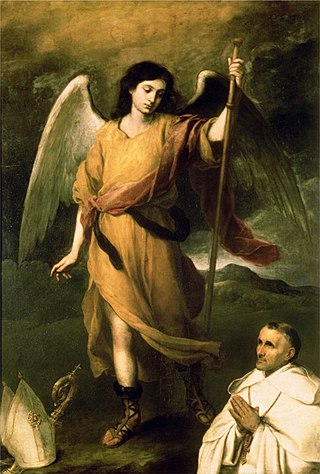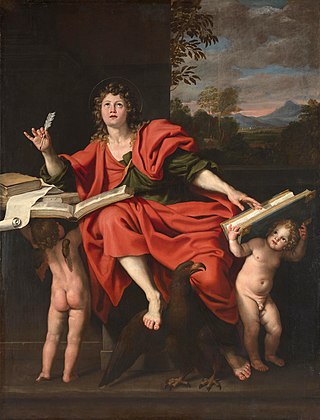Related Research Articles

Archangels are the second-lowest rank of angel in the Christian hierarchy of angels, put forward by Pseudo-Dionysius the Areopagite in the 5th or 6th century in his book De Coelesti Hierarchia. The word "archangel" itself is usually associated with the Abrahamic religions, but beings that are very similar to archangels are found in a number of other religious traditions.

Metatron, or Matatron, is an angel in Judaism, Christianity, and Islam mentioned three times in the Talmud, in a few brief passages in the Aggadah, and in mystical Kabbalistic texts within Rabbinic literature. The figure forms one of the traces for the presence of dualist proclivities in the otherwise monotheistic visions of both the Tanakh and later Christian doctrine. In the Jewish kabbalistic tradition, he is sometimes portrayed as serving as the celestial scribe. The name Metatron is not mentioned in the Torah or the Bible, and how the name originated is a matter of debate. In Islamic tradition, he is also known as Mīṭaṭrūn, the angel of the veil.

In the Hebrew Bible, the name Azazel represents a desolate place where a scapegoat bearing the sins of the Jews was sent during Yom Kippur. During the late Second Temple period, Azazel came to be viewed as a fallen angel responsible for introducing humans to forbidden knowledge, as described in the Book of Enoch. His role as a fallen angel partly remains in Christian and Islamic traditions.

A seraph is a celestial or heavenly being originating in Ancient Judaism. The term plays a role in subsequent Judaism, Christianity, and Islam.

Raphael is an archangel first mentioned in the Book of Tobit and in 1 Enoch, both estimated to date from between the 3rd and 2nd century BCE. In later Jewish tradition, he became identified as one of the three heavenly visitors entertained by Abraham at the Oak of Mamre. He is not named in either the New Testament or the Quran, but later Christian tradition identified him with healing and as the angel who stirred waters in the Pool of Bethesda in John 5:2–4, and in Islam, where his name is Israfil, he is understood to be the unnamed angel of Quran 6:73, standing eternally with a trumpet to his lips, ready to announce the Day of Judgment. In Gnostic tradition, Raphael is represented on the Ophite Diagram.

Fallen angels are angels who were expelled from Heaven. The literal term "fallen angel" does not appear in any Abrahamic religious texts, but is used to describe angels cast out of heaven or angels who sinned. Such angels often tempt humans to sin.

The Book of Enoch is an ancient Hebrew apocalyptic religious text, ascribed by tradition to the patriarch Enoch who was the father of Methuselah and the great-grandfather of Noah. The Book of Enoch contains unique material on the origins of demons and Nephilim, why some angels fell from heaven, an explanation of why the Genesis flood was morally necessary, and a prophetic exposition of the thousand-year reign of the Messiah. Three books are traditionally attributed to Enoch, including the distinct works 2 Enoch and 3 Enoch.

Theophany is an encounter with a deity, in which it manifests in an observable and tangible form. Where the deity does not take tangible form, the broader term used for inward manifestation is divine revelation or divine inspiration. Where the god indwells in a human person, the terms used are divine incarnation, an avatar, or, poetically, the personification of that deity. Theophanies, tangible appearances of a god, are distinguished from epiphanies, which are powerful internal changes in outlook caused by a theophany or other divine revelation.
Sariel is an angel mainly from Judaic tradition. Other possible versions of his name are Suriel, Suriyel, Seriel, Sauriel, Saraqael, Sarakiel, Suruel, Surufel, and Souriel.

Merkabah or Merkavahmysticism is a school of early Jewish mysticism, c. 100 BCE – 1000 CE, centered on visions such as those found in Ezekiel 1 or in the hekhalot literature, concerning stories of ascents to the heavenly palaces and the Throne of God.

The Israʾ and Miʿraj are the two parts of a Night Journey that Muslims believe the Islamic prophet Muhammad took during a single night around the year AD 621. Within Islam, the majority of scholars agree that the journey was both a physical and spiritual one. A brief mention of the story is found in the 17th surah (chapter) of the Quran, called al-Isra', while details of the story are found in the hadith.

Samyaza, also Shemhazai, Azza, Uzza, or Ouza, is a fallen angel of apocryphal Abrahamic traditions and Manichaeism who ranked in the heavenly hierarchy as the leader of the Watchers.

A Watcher is a type of biblical angel. The word occurs in both plural and singular forms in the Book of Daniel, where reference is made to the holiness of the beings. The apocryphal Books of Enoch refer to both good and bad Watchers, with a primary focus on the rebellious ones.
Seraphiel is the name of an angel in the apocryphal Book of Enoch.
The Second Book of Enoch is a pseudepigraphic text in the apocalyptic genre. It describes the ascent of the patriarch Enoch, ancestor of Noah, through ten heavens of an Earth-centered cosmos. The Slavonic edition and translation of 2 Enoch is of Christian origin in the 8th century but is based on an earlier work. 2 Enoch is distinct from the Book of Enoch, known as 1 Enoch, and there is also an unrelated 3 Enoch, although none of the three books are considered canonical scripture by the majority of Jewish or Christian bodies. The numbering of these texts has been applied by scholars to distinguish each from the others.

The ophanim, alternatively spelled auphanim or ofanim, and also called galgalim, refer to the wheels seen in Ezekiel's vision of the chariot in Ezekiel 1:15–21. One of the Dead Sea scrolls (4Q405) construes them as angels; late sections of the Book of Enoch portray them as a class of celestial beings who never sleep, but guard the throne of God. In Christian angelology, they are one of the choirs (classes) of angels, and are also called Thrones.

The events of Revelation are the events that occur in the Book of Revelation of the New Testament. An outline follows below, chapter by chapter.

The concept of Seven Archangels is found in some works of early Jewish literature and in Christianity. In those texts, they are referenced as the angels who serve God directly.
The Third Book of Enoch, also known as The Book of the Palaces, The Book of Rabbi Ishmael the High Priest and The Elevation of Metatron, and abbreviated as 3 Enoch) is a Jewish apocryphal book.
References
- ↑ "Kerubiel Angel". www.imaginova.com. Retrieved 2023-11-09.
- ↑ "Kerubiel". hafapea.com. Archived from the original on 2014-10-20. Retrieved 2023-11-09.